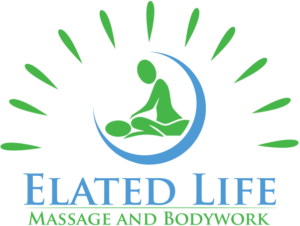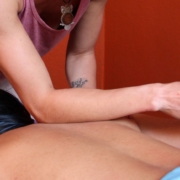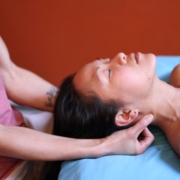Swedish Massage vs. Deep Tissue Massage: Which is Right for You?
One of the most confusing questions my clients have is what their preferred type of massage is. Although there are many different styles and types of bodywork, most people are only given the options of Swedish Massage and Deep Tissue Massage when they go to a spa. What exactly is the difference between the two? Before I was a massage therapist, I thought it was light pressure versus deep pressure, but there is much more than that.
Comparing Swedish Massage Vs. Deep Tissue Massage
What is a Swedish Massage?
Swedish massage was developed by a Swedish doctor and physical therapist named Per Henrik Ling, and is known for its therapeutic and relaxing benefits through the use of specific types of strokes and movement techniques. In a Swedish massage the therapist targets the superficial layers of muscle using a lighter pressure in the beginning and eases their way in through kneading the muscles, long, sweeping strokes, range of motion, rhythmic tapping and tapotement, friction, and shaking.
Kneading the muscles is similar to preparing baking dough. The therapist lifts the muscles, decompressing them, and moves them, giving space between the muscle and bone. This manipulates the muscle in a gentle way, preparing it for different Swedish massage techniques.
Long strokes, or effleurage, are what you are used to feeling in the beginning of a massage. The long, gliding strokes typically begin lighter and gradually get deeper as the knots and tension get broken up. The therapist will typically use the palm of their hand or fingers with these strokes.
Passive range of motion. The client allows the therapist to guide the movement of their limbs to lubricate the joints, loosen adhesions, and increase flexibility through bending and stretching.
Rhythmic tapping and tapotement can be done using soft fists, the sides of the hand, cupped hands, or the tops of the therapist’s fingers. This Swedish massage technique helps to loosen and relax the muscles, as well as energize them.
Friction brings heat and circulation to the muscles and is typically used to warm the muscles up in preparation for deeper massage. The palms or the sides of the therapist’s hands rub the client’s skin vigorously, in opposing directions, to produce heat by friction.
Shaking or vibration is a Swedish massage technique where the therapist uses any part of their hands to move in a back and forth motion over the skin to create a vibrating sensation in the muscles. The vibrations loosen and relax the muscles and is especially useful for clients who are feeling anxious, stressed, or overworked.
These techniques are meant to loosen and manipulate muscles, stimulate nerve endings, and increase blood circulation and lymph drainage. The goals of a Swedish massage are to help clients get into their parasympathetic nervous system and attain a level of deep relaxation.
Swedish Massage Benefits
Since the goal of Swedish massage is to relax the entire body, the benefits are both physical and mental, affecting the mind, body, and spirit. These benefits include:
- Pain management
- Increased nutrients and oxygen to muscles and removal of toxins
- Rehabilitation to injured muscles
- Increased flexibility and range of motion
- Reduced stress and anxiety by lowering cortisol levels in the body
- Reduced tension headaches
- Improved sleep
- Improved immune function
What is Deep Tissue Massage?
Deep tissue massage uses similar techniques to Swedish massage, but rather than working with the superficial layers of the muscles, it focuses on realigning the deeper layers of the muscles and connective tissue. The purpose of massaging deeper into the muscle layers is to release chronic muscle tension that develops through overuse, poor movement or postural patterns (sitting at a computer for long hours, breastfeeding, looking at your smartphone), muscle soreness, and athletic injuries.
Although many of the strokes and techniques are similar, deep tissue massage involves slower movements and deeper, more concentrated pressure on areas of pain or tension. This allows the muscles to open up in order for the therapist to get into the sub-layers of the muscle and fascia (the connective tissue surrounding the muscle fibers).
These deeper layers of the muscle are where we usually find the “knots” that most people complain about. Knots are typically found where there is chronic tension in muscles and tendons and are bands of painful, rigid tissue adhered together. Deep tissue works to release these adhesions, realign, and smooth out the muscle fibers in these areas. These areas are typically found in a stiff neck and upper back, between the shoulder blades, sore shoulders, leg muscle tightness, and low back pain.
Where there is pain or muscle tightness, there will most likely be adhesions. These adhesions can limit range of motion and movement, causing overcompensation in other areas of the body, which can result in pain, blocked circulation, and inflammation.
The goals of deep tissue massage are to facilitate healing through reducing the amount of adhesions in muscles, releasing contracted muscles, increasing circulation to soft tissue in areas of pain or tension, and to reduce inflammation.
Deep Tissue Massage Benefits
Deep tissue massage is usually applied to specific areas of the body. Although you may experience some pain during the massage, the goal is to maintain a level of relaxation, while working out the adhesions causing pain. Deep tissue massage can be used to treat several conditions and has many therapeutic effects, including:
- Lowers high blood pressure
- Reduced back pain
- Reduced arthritic pain and symptoms
- Rehabilitates muscles after a strenuous workout
- Rehabilitates injuries
- Breaks down scar tissue
- Reduced stress and anxiety
- Increased joint mobility and range of motion
- Reduced chronic pain
When receiving deep tissue massage it is important to communicate with your therapist in regard to pain. Massaging areas of chronic tension and pain can be very painful. As a rule of thumb, never let yourself go above an 8 out of 10. The goal is to release the adhesions, as well as keep your body in its parasympathetic nervous system, so you feel relaxed and the muscles are able to let go. You do not want to feel like jumping off the table. This can cause tension in other areas of your body as well as raise cortisol levels in the body.
Which Massage is Right for Me?
Now that you know the difference between Swedish massage and deep tissue, how do you know which one to ask for? You will have different options depending on if you go to a spa or a private practice massage therapist. The best way is to ask yourself what is your intention for the massage? What are you hoping to gain, and how do you want to feel after the massage?
Choosing the Right Massage
When you are choosing which massage is right for you at the time, talk to your massage therapist. Tell them what you are feeling and needing for the session. If you are at a spa and are unsure, it is always safe to choose one, and if you find that your needs change when you are on the table, let the therapist know. It is never too late to change what the therapist is doing. If you are in a spa, the massage therapist can always have the front desk charge you differently after the session ends.
In my practice, and with most massage therapists who work for themselves, I do a combination of the two styles, along with other techniques such as myofascial release, neuromuscular, and trigger point therapy, which are other forms of deep tissue massage. Working in this way, without having to stick to one style, helps the therapist work intuitively on what is needed in different areas of the body.
What can be confusing in this decision is if you want deep tissue in one area of your body but a relaxing, Swedish massage on the rest of your body. If you are at a spa, consider getting a deep tissue massage, and explain your needs to the therapist.
The most important thing to consider is what your needs are and what you want to gain. Consider the benefits of each style, as well as what you are feeling in your body at the moment. Massage therapy is a great way to get more connected with your body. Communicating with the therapist during the massage about what you feel and how much pressure is necessary is an integral part of creating a relationship and a deeper connection with your body. Massage therapy is a beautiful way of connecting one’s mind, body, and spirit, making one feel more whole and in tune.






Leave a Reply
Want to join the discussion?Feel free to contribute!